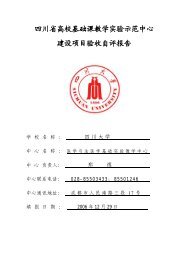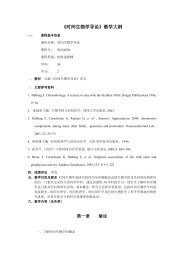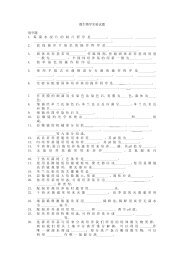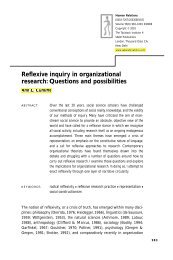Species
Species
Species
You also want an ePaper? Increase the reach of your titles
YUMPU automatically turns print PDFs into web optimized ePapers that Google loves.
Microbial Classification andIdentification第 十 一 章 : 微 生 物 的 分 类 和 鉴 定
Microbial Taxonomy 微 生 物 分 类学• Task1. Classification 分 类General → specific2. Identification 鉴 定specific → General3. Nomenclature 命 名
Seven Taxa 七 个 分 类 单 位• Kingdom 界 ( 拉 : Regnum)• Phylum (or Division) 门 ( 拉 : Phylum,Divisio)• Class 纲 ( 拉 : Classis)• Order 目 ( 拉 : Ordo)• Family 科 ( 拉 : Familia)• Genus 属 ( 拉 : Genus)• <strong>Species</strong> 种 ( 拉 : <strong>Species</strong>)
The Concept of SPECIES 种 的 概念• Hard to define microbial speciesSex 性 : not applicable due to the lack of sexMorphology 形 态 学 : too simple to be usedfor definition of speciesType species 模 式 种 : type strain used toshow speciesDNA identification 鉴 定 : start to be used inspecies definition
Classification 分 类 Family 科 : related genera Genus 属 : related species Type 型 : sub-set set of species <strong>Species</strong> 种 : related strains Strain 菌 株 : one single isolate or line
Other concepts related tospecies与 “ 种 ” 有 关 的 一 些 概 念• Subspecies 亚 种 , subsp., ssp.• Variety 变 种 , var.• Group 类 群• State 态 : mutation on colony 菌 落
Nomenclature 命 名• Common name, vernacular name 俗 名 Tubercle bacillu 结 核 杆 菌 Mycobacterium tuberculosis 结 核 分 支 杆 菌• Scientific name 学 名
Binomial Nomenclature 双 名 法• Carl von Linne 林 奈 , 1753• Use only the Genus 属 名 and species 种 名 Homo sapien 人 类 ,Felis domestica 家 猫 Escherichia coli 埃 希 杆 菌 Bacillus subtilis 枯 草 芽 胞 杆 菌 Saccharomyces cerevisiae 酿 酒 酵 母• Genus & species either underlined or italicized• Genus is always CAPITALIZED• <strong>Species</strong> is never capitalized
Naming of Bacteria 细 菌 命 名• Information usually given:1. Describes an organism Bacillus 杆 菌 , Streptococcus 链 球 菌2. Identifies a habitat 栖 息 地 E. Coli3. Honors a scientist or researcher Shigella 志 贺 菌 属
Other Information• Genus 属 Usually comes from Latin 拉 丁 语 Common abbreviation≈ Bac. or B. – Bacillus 杆 菌 属≈ P. or Ps. – Pseudomonas 假 单 胞 菌≈ A. or Asp. – Aspergillus 曲 霉• <strong>Species</strong> 种 sp. or spp. (pl) – species≈ Bacillus spp.
Bacteria vs. Archaebacteria真 细 菌 与 古 细 菌• Eubacteria 真 细 菌 peptidoglycan (murein) 肽 聚 糖≈ muramic acid 胞 壁 酸• Archaebacteria 古 细 菌 Pseudomurein 假 胞 壁 质 ( 肽 聚 糖 )≈ no muramic acid 无 胞 壁 酸• Difference1. Cell wall2. Lipid in membrane3. 16S rRNA≈ sequence vary
Bacterial Classification 细 菌 分类• Bergey’s Manual of SystematicBacteriology 伯 杰 氏 系 统 细 菌 学 手 册• The 9th edition by now• Classification based on 依 据Traditional morphology 传 统 形 态 学Modern biological information 现 代 生 物 学 信 息≈ e.g. G+C mol%, nucleic acid hybridization 核 酸 杂 交 ,16S rRNA sequence
Introduction to Bergey’sManual1. Volume 1 (2001)The Archaea and the deeply branching and phototrophicBacteria, ISBN 0-387-98771-12. Volume 2 (2001) The Proteobacteria, ISBN 0-387-95040-03. Volume 3 (2002) The low G+C Gram+ Bacteria, ISBN 0-387-95041-94. Volume 4 (2002) The high G+C Gram- Bacteria, ISBN 0-387-95042-75. Volume 5 (2003)The Planctomycetes, Spriochaetes, Fibrobacteres,Bacteriodetes and Fusobacteria, ISBN 0-387-95043-5
Methodology of MicrobialClassification and Identification微 生 物 分 类 和 鉴 定 方 法 学
Typical Culture LaboratoryBench
Four Levels at which MicrobialClassification Are Performed1. Cell 细 胞Morphology 形 态 学Habit 习 性2. Cellular components 细 胞 组 分Cell wall, lipid, pigmentRegular techniques, GC, HPLC, MS3. Protein 蛋 白 质 水 AA sequence, gel electrophoresis, immunolabeling4. Nucleic acid 核 酸G+C %, nucleic acid hybridization, genesequencing, genome sequencingClassicModern
Taxonomic characterizationof bacteria 细 菌 分 类 学 特 征• Classically based on1. Morphology 形 态 学2. Chemical analysis – Chemotaxonomy 化 学分 类 学3. Molecular analysis – Numerical taxonomy数 值 分 类 学• <strong>Species</strong> comparisons involving multiplestrains
Classic IdentificationStandards• Morphology 形 态 学• Physiological and biochemical test 生 理生 化 测 试• Growth and ecological features 生 长 生态 特 点• Life cycle 生 活 史• Serology 血 清 学• Sensitivity to phage 对 噬 菌 体 敏 感 性• other
Process of BacterialIdentification 细 菌 鉴 定 过 程1. Isolation (culture) 培 养物 分 离‣ Agar plate/colonies‣ Liquid media test tube– bulk2. Identification & taxonomy鉴 定 和 分 类‣ Family‣ Genus‣ <strong>Species</strong>‣ Type‣ Strain3. Biochemical (physiological) tests生 化 生 理 试 验Molecular tests 分 子 试 验 DNA-DNA homology 16S rRNA sequencingChemical profiling 化 学 组 合4. Non culture based detection 无 培 养 物 测 定 Polymerase chain reaction- (PCR) Agglutination(antigen detection) 凝 集 Stain 染 色 Serology (antibody detection) 血 清 学
Isolation and identification:Classic1. Streaking culture plates 划 线 培 养Colonies 菌 落 size, texture, color, hemolysis 溶 血oxygen requirement 需 氧 量2. Colonies Gram stained 菌 落 革 兰 氏 染 色cells observed microscopically 显 微 镜3. Isolated bacteria specializedGenerally: physiological tests 生 理 学 试 验≈Acid production, Carbon source4. Antibiotic susceptibility testing
Blood Agar Plate 血 琼 脂 平 板
Gram+
Microscopy 显 微 术• Spinal fluids 脊 髓 液(meningitis 脑 膜 炎 )• Sputum 痰 (tuberculosis结 核 病 )• Poor sensitivity 灵 敏 度 差
Serologic identification血 清 学 鉴 定• antibody response to the infectingagent 对 感 染 物 的 抗 体 反 应• several weeks after an infection hasoccurred 需 数 周 时 间
Rapid “Strep” Test 快 速 链 锁 测 试AntibodyStreptococcalantigenic extractLatex beads
Antibiotic susceptibility testing抗 生 素 敏 感 性 测 试Susceptible 易 感 的Not susceptibleBacteriallawn 菌 苔NogrowthGrowthAntibiotic disk
Modern microbial autoidentification微 生 物 的 自 动 化 鉴 定• API system• Biolog:ATC US
API Systemcultureno.ONPGDHLCODCCIT2SUETDAINDVPGELGLUMANIOSORRHASACMELAMYARAidentification8030 + – + – + – + – – + – + + + + + + + + + Klebsiella pneumoniae8068 – – – – – + + + + – + + – – – – + – + – Proteus vulgaris 变 形 菌8P14 – – + + – + – – – – – + + – + + – + – + Salmonella sp.
• Identify over 1900species of bacteria,yeast & filamentousfungiBiolog
Rapid diagnosis without culture无 培 养 物 的 迅 速 诊 断• WHEN AND WHY?• Grow poorly Isolation, slow, may not be clinicallyuseful• Can not be cultured Treponema pallidum 梅 毒 螺 旋 体
Identification in diagnostic laboratory诊 断 化 验 室 的 鉴 定• Aids treatment 酸 处 理• Susceptibility – antibiotic selection 抗 生素 敏 感 性• Based on taxonomy 分 类 学• Simple, low cost, rapid
Modern molecular analysis分 子 水 平 上 的 分 析• Historicalguanine (G)+ cytosine (C) (% GC)• Gene analysisDNA Hybridization 杂 交Gene characterization 基 因 特 征≈≈Sequencing 序 列 分 析other
G + C mol% method• Hghly determines the Tm 解 链 温 度Within the same species: (G+C)% shouldbe similarDifferent species: may or may not besimilar• To exclude the uncertain Taxon 分 类 单元 , but not use it to set up a newspecies.
DNA-DNA hybridization 杂 交• Groups bacterial strains into species• Below species levellittle or no relatedness
DNA-DNA hybridizationHeatStrain 1+Strain 20% Homology100% Homology同 源
Bacterial DNA sequences amplified扩 增 directly from human body fluids• Polymerase chain reaction (PCR) 多 聚酶 链 反 应Great success in rapid diagnosis oftuberculosis 快 速 诊 断
16S rRNA Sequencing• Relative constant (53%) during evolution• Similarity above species level• Closely related species: may be identical• Allows relatedness comparisons of allbacteria• Development of clinical tests based onsequence
Structural profiles 结 构 组 合 表• Long chain fatty acids 长 链 脂 肪 酸 widely used• Carbohydrates 碳 水 化 合 物• Ubiquinones 泛 醌
Metabolic Profiles 代 谢 组 合 表• Volatiles 挥 发 物* Alcohols 酒 精* Short chain fatty acids 短 链 脂肪 酸
Numerical Taxonomy• Taxonometrics: computer taxonomy• 1957, P. H. Sneath• Operational taxonomic units (OTU) 运 算分 类 单 位 : a variety of strains1. Calculate correlation coefficient 相 关 系 数2. Give similarity matrices 相 似 度 矩 阵3. Dendrogram 树 状 分 枝 图 : only phenon 同 型种 or phenotic group, not taxon
Dendrogram树 状 分 枝 图
Key Points1. What are the five kingdoms 五 界 系 统2. The criterion of defining the threedomains 三 域 划 分 的 标 准3. Binomial Nomenclature 双 名 法4. Eubacteria vs. Archaebacteria5. The four major process of bacterialidentification 细 菌 鉴 定 的 四 个 主 要 步 骤













![第10 ç« æ¢ç弯æ²åºåMPa 30 MPa 36 kN/m 5.4][ = q = ][q](https://img.yumpu.com/29939822/1/184x260/c10-c-aeca-1-4-aeaampa-30-mpa-36-kn-m-54-q-q.jpg?quality=85)


